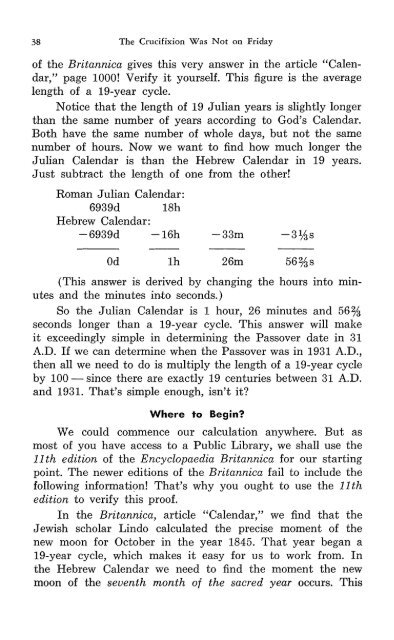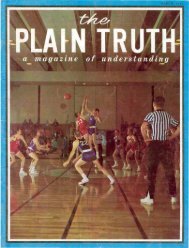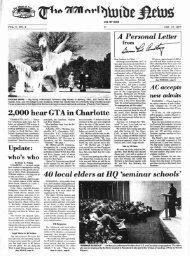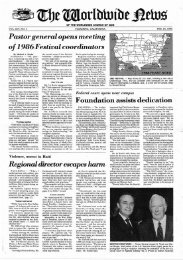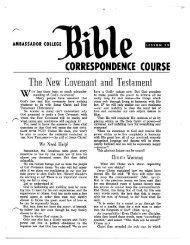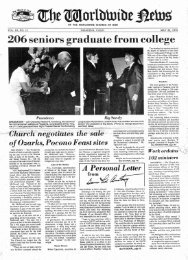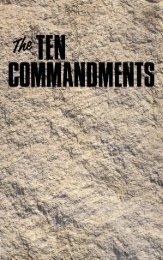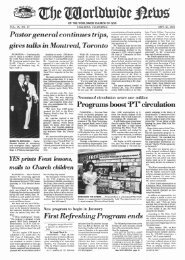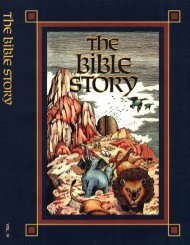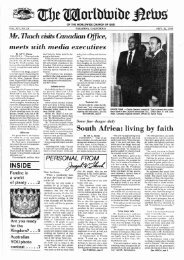Crucifixion Was Not on Friday (1968)_b.pdf - Herbert W. Armstrong
Crucifixion Was Not on Friday (1968)_b.pdf - Herbert W. Armstrong
Crucifixion Was Not on Friday (1968)_b.pdf - Herbert W. Armstrong
Create successful ePaper yourself
Turn your PDF publications into a flip-book with our unique Google optimized e-Paper software.
38 The <str<strong>on</strong>g>Crucifixi<strong>on</strong></str<strong>on</strong>g> <str<strong>on</strong>g>Was</str<strong>on</strong>g> <str<strong>on</strong>g>Not</str<strong>on</strong>g> <strong>on</strong> <strong>Friday</strong><br />
of the Britannica gives this very answer in the article "Calendar,"<br />
page 1000! Verify it yourself. This figure is the- average<br />
length of a 19-year cycle.<br />
<str<strong>on</strong>g>Not</str<strong>on</strong>g>ice that the length of 19 Julian years is slightly l<strong>on</strong>ger<br />
than the same number of years according to God's Calendar.<br />
Both have the same number of whole days, but not the same<br />
number of hours. Now we want to find how much l<strong>on</strong>ger the<br />
Julian Calendar is than the Hebrew Calendar in 19 years.<br />
Just subtract the length of <strong>on</strong>e from the other!<br />
Roman Julian Calendar:<br />
6939d 18h<br />
Hebrew Calendar:<br />
-6939d -16h<br />
-33m<br />
-3~s<br />
ad 1h 26m 56%s<br />
(This answer is derived by changing the hours into minutes<br />
and the minutes into sec<strong>on</strong>ds.)<br />
So the Julian Calendar is 1 hour, 26 minutes and 56%<br />
sec<strong>on</strong>ds l<strong>on</strong>ger than a 19-year cycle. This answer will make<br />
it exceedingly simple in determining the Passover date in 31<br />
A.D. If we can determine when the Passover was in 1931 A.D.,<br />
then all we need to do is multiply the length of a 19-year cycle<br />
by 100 - since there are exactly 19 centuries between 31 A.D.<br />
and 1931. That's simple enough, isn't it?<br />
Where to<br />
Begin?<br />
We could commence our calculati<strong>on</strong> anywhere. But as<br />
most of you have access to a Public Library, we shall use the<br />
11th editi<strong>on</strong> of the Encyclopaedia Britannica for our starting<br />
point. The newer editi<strong>on</strong>s of the Britannica fail to include the<br />
following informati<strong>on</strong>! That's why you ought to use the 11th<br />
editi<strong>on</strong> to verify this proof.<br />
In the Britannica, article "Calendar," we find that the<br />
Jewish scholar Lindo calculated the precise moment of the<br />
new mo<strong>on</strong> for October in the year 1845. That year began a<br />
19-year cycle, which makes it easy for us to work from. In<br />
the Hebrew Calendar we need to find the moment the new<br />
mo<strong>on</strong> of the seventh m<strong>on</strong>th of the sacred year occurs. This


